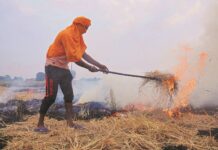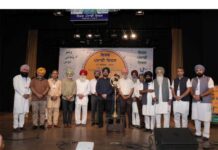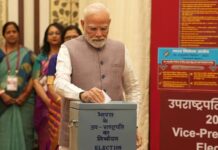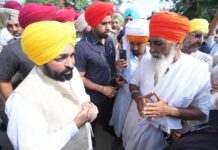Jaswant Singh Gandam & Raman Nehra
PHAGWARA: The 21st edition of Indians Abroad and Punjabi Impact, brought out by UK-based NRI journalist and writer N.S. Shergill, was released here on February 26.
Having the sub-title “Samundron Par Da Punjabi Sansar”, the edition is a special one dedicated to the coming 550th ‘Parkash Purb’ of Guru Nanak Dev, the founder of the Sikh faith.
The release function was attended by a large number of Punjabi writers, columnists and journalists.
It was organized by literary and cultural organization Punjabi Virsa Trust and a Punjabi monthly magazine Sangeet Darpan.
A presidium of eminent writers and columnists, including N.S. Shergill, Dr Harjinder Singh Walia, Dr Asa Singh Ghuman, Ujagar Singh, Dr Shyam Sunder Dipti, US-based NRI Dr Charanjit Singh Gumtala, Gurmit Palahi, Jaswant Singh Gandam and Taranjit Singh Kinra presided over the function.
Two resolutions were unanimously adopted.
One demanded creation of a Rs 100-crore corpus fund for promotion of Punjabi language and culture on the occasion of 550th birth anniversary celebration of Guru Nanak Dev who chose Punjabi as the medium of his message.
The second called upon leaders in home and abroad to shun war and resolve issues through dialogue which was the main method of Guru Nanak for settling issues.
Speaking on Shergill’s huge effort in accomplishing an Herculean task by bringing out a voluminous 410-page colorful book, various writers hailed it as an authentic reference book about Punjabi diaspora.
Hailing its encyclopaedic range as far as ready information about Punjabis settled in 50 different countries of the world was concerned, speakers said it provided “perambulation of the world”.
Calling it a “havala pustak” (reference book), they said it had achieved global meaning and acceptance as a ready reckoner of Punjabi diaspora.
Having mesmerizing colorful shining pictures, the book has 47 pages of International directory, including business directory, of Punjabi NRIs, 48 pages of Sikh organisations and gurdwaras, and five pages of Indian newspapers outside India. Radio stations, TV channels, online papers are also mentioned.
Around 2, 000 Sikh organizations and gurdwaras, with 84,000 Guru Ghar De Sevak, find mention in it. So do over 200 registered recognized institutions.
Punjabi NRI achievers, entrepreneurs having Rs b2 crore to 4000 crore capital, information of 160 embassies and missions in New Delhi and other parts of India, 200 international STD codes,1,175 cities’ national STD codes also find mention.
A large number of articles by eminent Sikh scholars on Guru Nanak Dev, Guru Gobind Singh, holy Guru Granth Sahib, Sikhism, its history and its centers of worship make it worth decking your library.
Speaking on Guru Nanak Dev’s message and philosophy, speakers said it was “samvaad” (dialogue), “sehansheelta” (tolerance), and “samanta” (equality).
Author Shergill, speaking on the occasion, regretted the lack of impartial journalists in India.
Denouncing double-faced journalism, Shergill advised journalists not to be hypocrites by hunting with the hound and running with the hare.
“Many journalists claim to be critics of establishment but have back-door good relations with it,” he said top clarify his point.
Taking umbrage to the use of prefix “parvasi”, Shergill asserted that Punjabis settled abroad were not parvasis (migrants) but sons of the soil who had gone abroad in search of greener pastures.
“Punjabi intellectuals should find out some other honourable sobriquet as ‘parvasi’ word for Punjabi NRIs smelt of ‘begangi’ (alienation) and ‘ajnabipan’(strangerhood)”,he pleaded.
Kulbir Singh said that control of media by corporate and industrial houses in country was putting hurdles in way of objective journalism.
Punjabi poets Harbhajan Virk and Baldev Komal read out their poems.
UK-based Punjabi singer K.S. Bhamra, Bhupinder Singh Kandra from Austria, and UK’s Jaswinder Singh Rehnci also attended the function.







